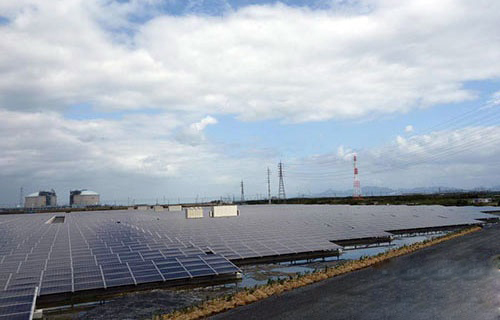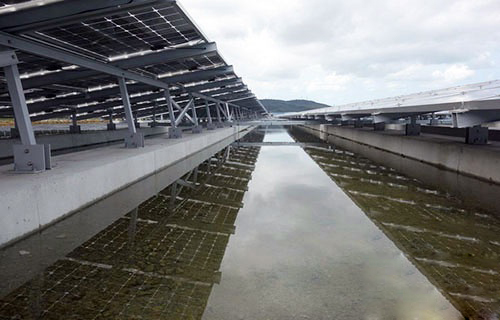 |
Japan's Western Gas Group and Asahi Glass's joint venture special purpose company (SPC) ENESEDED HIBIKI (Fukuoka City, Fukuoka Prefecture) and the 20.5 MW megawatt photovoltaic power station “ENESEED HIBIKI PV Power Plant†built in Kitakyushu City, Fukuoka Prefecture had been in 2014. October full load operation.

"ENESEED HIBIKI Photovoltaic Power Plant" of 2 megawatt Photovoltaic Power Plant with Output Power of 20.5 MW
The first step in the transition to a double-sided solar panel
The megawatt photovoltaic power station has set up about 81,000 solar panels. The original solar panel (39,987 pieces) and the newly developed double-glazed panel (4,1216 pieces) are each about 10MW.
Double-glazed solar panels are one of the technologies that are expected to be low-cost, high-output, and high-reliability for megawatt photovoltaic power plants in the future. Due to the closed structure sandwiched by two pieces of glass, the back film and aluminum frame used in the original solar panel can be eliminated.
However, at present, in terms of cost reduction, high output power, and high reliability, only the increase in hermeticity satisfies the conditions for high reliability.
High reliability is achieved by using a glass instead of a resin back film for sealing on the back surface, thereby reducing the risk of water invasion leading to deterioration.
The panel is suitable for use in harsh environments such as saline and alkaline lands, deserts, etc. It can also cope with a degradation phenomenon named PID (Potential Induced Degradation) that occurs under high temperature and high humidity conditions.
In order to realize the advantages of cost reduction and high output power, it is also necessary to reduce the cost of the “double-sided light receiving type solar cell†that has the advantage of being transparent on the backside, and to reduce the production of solar panels using thin glass. cost.
Both sides are chemically strengthened glass with a thickness of 1.1mm
Mitsubishi Electric's solar panels use chemically strengthened glass with a thickness of only 1.1mm.

Double-glazed solar panels using chemically strengthened glass with a thickness of only 1.1mm
Mitsubishi Electric emphasizes that the use of a chemically-strengthened glass panel with a thickness of 1.1 mm at a panel size of 10 MW will also minimize its impact on the manufacturing process of solar panels, which is of epoch-making significance.
The glass used is chemically strengthened glass "Leoflex" manufactured by Asahi Glass. Its average weight was reduced by about 21% to about 9.1 kg/m 2 compared to about 11.5 kg/m 2 of the original panel composed of a 3.2 mm thick glass and a back film.
Planting trees to protect weeds with clover
The design, procurement, and construction (EPC) services of the megawatt photovoltaic power plants are managed by NTT facilities and Dacheng Construction. The inverter is a product of Toshiba Mitsubishi Electric Industrial Systems (TMEIC).
In addition, low planting trees were planted on the south side of the power station site for greening purposes. Measures to prevent the growth of weeds have also taken into account greening and planting clover. It is known that clover has the effect of preventing the growth of other weeds. However, the status quo is that clover is unevenly rooted in large areas and its effect is still being verified.
Our company produces a vary of specifications of Glass Particles and glass-lumps which can be used in ordinary pavement of road to shorten braking distance effectively, to improve the warning role and to decelerate in advance to achieve safety. Pavement laid with this product will not peel off and maintain function well after a long time wheel friction.
It is also used in the decoration of building outer-walls and all kinds of ceramic. There is mainly 1-2 mm, 2-3 mm, 3-4 mm, 600-850 microns, 300-600 microns, 180-300, and less than 180 microns etc. as well customized specifications customers require.
The glass bead can be produced based on the standard of countries or areas, such as EN1423/1424, AASHTO M247, BS6088, JIS R3301 and KS L2521 etc.

Glass Particles
Glass Particles,Plastic Glass Particles,Color Fireproof Glass Particles,Crushed Colored Glass Particles
CHIYE GLASS BEAD (HEBEI) CO., LTD , https://www.chiyeglassbeads.com